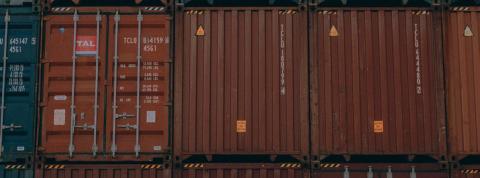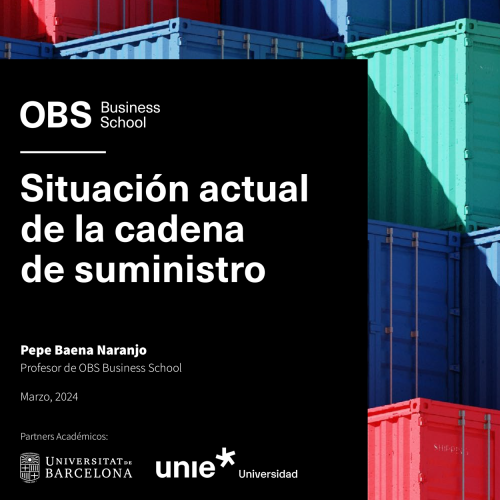
OBS Report: Current supply chain situation
Uncertainty in the supply chain will drive up costs
- Political conflicts, piracy, labour shortages, trade protectionism due to political interests and the need to reduce greenhouse gas emissions are the elements holding back the supply chain today.
- To avoid risks, an OBS report proposes not to base supplier decisions solely on cost but on their proximity and ability to cope with surges in demand.
- AI is enabling better inventory management, smart manufacturing, dynamic logistics systems and real-time delivery controls. The potential of the Metaverse in this field is enormous.
March 2024. OBS Business School publishes the report Current situation of the supply chain, directed by Professor Pepe Baena, director of the Master's Degree in Production Management and Industrial Automation at the school. The study analyses the causes that are provoking continuous supply clashes and that have already become the norm rather than the exception. The report identifies several causes: on the one hand, wars and political conflicts, piracy, labour shortages in the sector and trade protectionism due to political interests; on the other hand, the need to reduce gas emissions into the atmosphere. The report proposes the application of AI and the Metaverse throughout the supply chain.
Current context
In the wake of Russia's attack on Ukraine, the black seaport has become non-operational, leading to the cessation of supplies of several commodities such as transport equipment, machinery, electronics, metals, chemicals, fertilisers and some foodstuffs. In the Middle East, the Israeli-Palestinian conflict could eventually involve other countries in the region, causing disruptions in production and transportation, leading to price volatility and possible shortages in global markets. On the other hand, in the Far East, China is interested in taking over Taiwan in 2027 in a peaceful manner, but without ruling out the use of force; a country whose economy is largely based on the production of parts and components for other products, especially technological ones, which are sold mainly in Japan, the United States and the European Union.
These conflicts are compounded by the problem of labour shortages in transport and warehousing, which is causing wage increases to reach a new all-time high due to competition between companies for workers. This is further exacerbating disruptions in the global trade network. Moreover, since the 2008 global financial crisis, governments have embarked on increasingly protectionist policies and at least 37 countries have established investment screening mechanisms, an exercise in balancing the protection of national security with the encouragement of productive foreign investment. For example, the United States generally gives the green light to investors from Australia, Britain, Canada and New Zealand; and some European Union countries restrict non-EU investors while others widen the circle to members of the European Free Trade Association. Trade facilitation measures have already been implemented in recent years and the rules-based multilateral system has succeeded in stopping the 164 members of the World Trade Organisation (WTO) in their flight to protectionism.
Supply chain sustainability
The need to make the movement and storage of goods increasingly sustainable is forcing changes in all the dynamics and processes within the supply chain of companies. Reducing gas emissions into the atmosphere is increasingly a disruptive element as many companies, especially smaller ones, are not prepared to assume the costs that these changes will generate. Added to this are all the disruptions that climate change is causing, floods, drought, tornadoes, etc., which are affecting the primary sector in particular and, of course, transport as well.
How to avoid risks
The report argues that it is no longer appropriate to base supplier decisions solely on cost. Part of developing resilient supply chains, in the midst of disruption, is being able to readapt them as the next supply shock arrives. "Otherwise, any cost savings will quickly evaporate as a concentrated supply base disappears, and procurement and sourcing departments will be left in 'reaction mode' as they scramble to find alternatives, sometimes regardless of price," says Pepe Baena. And he believes that purchasing and procurement departments can and should compensate for concentration risks and avoid major disruptions.
Developing resilient supply chains means, among other things and according to the report, embracing digitisation, because digitisation leverages data to improve visibility, from supplier health and partial cost-saving opportunities to emerging risks and even supplier communications. Departments gain insights they couldn't dream of with a spreadsheet. In fact, automated alerts are already helping teams anticipate supply concentration risks and quickly find alternatives before a disruption occurs.
The technological advances spawned by Industry 4.0 are already shaping logistics and supply chains. On the one hand, the industry has embraced AI on a large scale, which is enabling better inventory management, smart manufacturing, dynamic logistics systems and real-time delivery controls. On the other hand, the potential of the Metaverse in this field is enormous because it allows for increased transparency and visibility into how products are manufactured, stored, distributed and sold. Metaverse promotes collaboration throughout the supply chain, both upstream and downstream, making it more efficient and effective, and enables better planning of warehouses even before they are built, saving time and money. In e-commerce, the Metaverse will bring together the best of the in-store experience and customer service with the opportunity to shop from home thanks to its ability to mix products, communicate their features and answer any queries in real time before the purchase is made. It will be a dramatic change in consumer shopping habits.
But, in addition, the OBS report recommends companies to look for nearby suppliers in order to avoid restrictions due to border closures or labour shortages in ports; also to carry out supplier audits to determine their real capacity and thus prevent a possible increase in demand for certain products; and to carry out periodic and continuous demand reviews.
The importance of resilient supply chains will be vital in the coming years and many companies have already begun to rethink their strategies, seeking to diversify suppliers, reduce dependence on specific regions and adopt technologies that improve visibility and agility in the supply chain. This is a scenario that, for the time being, only poses uncertainty and will lead to increased costs, and is not expected to be stable in the short term.
Content written by:
Carmen García-Trevijano
OBS Business School Press Office

